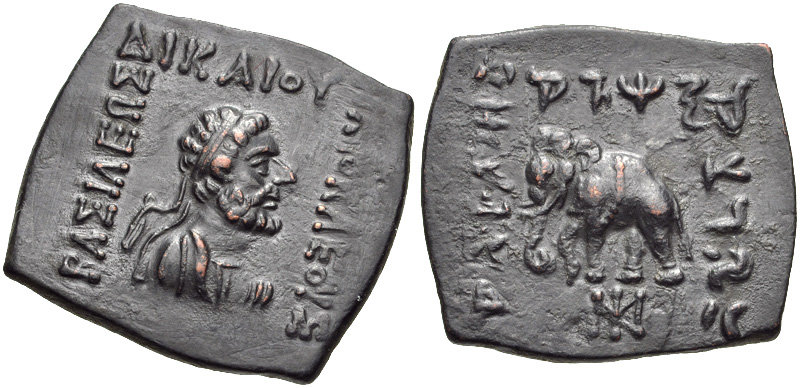Heliokles II on:
[Wikipedia]
[Google]
[Amazon]


 Heliocles II Dicaeus (
Heliocles II Dicaeus (


 Heliocles II Dicaeus (
Heliocles II Dicaeus (Greek
Greek may refer to:
Greece
Anything of, from, or related to Greece, a country in Southern Europe:
*Greeks, an ethnic group.
*Greek language, a branch of the Indo-European language family.
**Proto-Greek language, the assumed last common ancestor ...
: ; epithet means "the just") is thought to have been one of the later Indo-Greek
The Indo-Greek Kingdom, or Graeco-Indian Kingdom, also known historically as the Yavana Kingdom (Yavanarajya), was a Hellenistic-era Greek kingdom covering various parts of Afghanistan and the northwestern regions of the Indian subcontinent ( ...
kings and a relative of the Bactrian king Heliocles I
Heliocles I ( grc, Ἡλιοκλῆς, Helioklēs; reigned 145–120 BCE) was a Greco-Bactrian king, brother and successor of Eucratides the Great, and considered (along with his co-ruler and son/nephew Heliocles II) the last Greek king to reign ...
. Current scholarly consensus is that he ruled ca 95–80 BCE.
Heliocles II seems to have been engaged in a series of wars with Strato I
Straton or Strato may refer to:
* Strato I, Indo-Greek king
* Strato II, Indo-Greek king
* Strato of Lampsacus (c. 335 – c. 269 BC), Greek philosopher
* Straton of Sardis, Greek poet and anthologist
* Abdashtart I (Straton I, 365–352 BC), king ...
in Gandhara and Punjab
Punjab (; Punjabi: پنجاب ; ਪੰਜਾਬ ; ; also romanised as ''Panjāb'' or ''Panj-Āb'') is a geopolitical, cultural, and historical region in South Asia, specifically in the northern part of the Indian subcontinent, comprising a ...
; the two share several mintmarks and Heliocles II overstruck many of his coins. During this period, a number of kings fought for hegemony in the Indo-Greek territories. Some of them were likely supported by nomad Saka rulers such as Maues
Maues (Greek: ; (epigraphic); Kharosthi: , , called , on the Taxila copper plate; also called , in the Mathura lion capital inscription,) was the first Indo-Scythian king, ruling from 98/85 to 60/57 BCE. He invaded India and establi ...
.
Genealogy
Heliocles II used a reverse of standingZeus
Zeus or , , ; grc, Δῐός, ''Diós'', label= genitive Boeotian Aeolic and Laconian grc-dor, Δεύς, Deús ; grc, Δέος, ''Déos'', label= genitive el, Δίας, ''Días'' () is the sky and thunder god in ancient Greek reli ...
, who was a common deity among the later Indo-Greek kings. J. Jakobsson sees Heliocles as the son of the important king Antialcidas
Antialcidas Nikephoros ( grc, Ἀντιαλκίδας ὁ Νικηφόρος; epithet means "the Victorious", Brahmi: 𑀅𑀁𑀢𑀮𑀺𑀓𑀺𑀢𑀲 ''Aṃtalikitasa'', in the Heliodorus Pillar) was a king of the Indo-Greek Kingdom, who re ...
Nikephoros (whose type was sitting Zeus) and perhaps the grandson of Heliocles I.
He goes on to suggest that Heliocles was the older brother of the king Archebius Nikephoros Dikaios, who seems to have succeeded Heliocles II in Gandhara (perhaps after his death from disease; Heliocles I looks emaciated on his later portraits). Archebius uses a very similar reverse and combines the epithets of Heliocles II and Antialcidas; in addition, their coin portraits are similar, with hooked noses and fierce expressions.
R.C. Senior has instead suggested a connection with Demetrius III, who used a similar reverse of standing Zeus.
Coins of Heliocles II
Heliocles II issued Indian silver with portrait (diademed, helmeted or spear-throwing) / standing Zeus and bronzes with bearded diademed portrait (Heliocles or Zeus) / elephant. It is uncertain whether he struck Attic coins. A number of posthumous coins for Heliocles I have been found in Bactria; possibly some of these may have been struck by Heliocles II, though there are no similar monograms.Overstrikes
The existence of numerousoverstrike
In typography, overstrike is a method of printing characters that are missing from the printer's character set. The character is created by placing one character on another one — for example, overstriking "L" with "-" results in printing a " ...
s helps locate the reign of Heliocles II in relation to other Indo-Greek kings. Heliocles overstruck coins of Agathokleia, Strato I
Straton or Strato may refer to:
* Strato I, Indo-Greek king
* Strato II, Indo-Greek king
* Strato of Lampsacus (c. 335 – c. 269 BC), Greek philosopher
* Straton of Sardis, Greek poet and anthologist
* Abdashtart I (Straton I, 365–352 BC), king ...
, and Hermaeus
Hermaeus Soter or Hermaios Soter ( grc, Ἑρμαῖος ὁ Σωτήρ; epithet means "the Saviour") was a Western Indo-Greek king of the Eucratid Dynasty, who ruled the territory of Paropamisade in the Hindu-Kush region, with his capital in ...
. Conversely, Amyntas overstruck coins of Heliocles II. These overstrikes suggest that Heliocles II reigned around 95–85 BCE and was a contemporary of Amyntas and Hermaeus Bopearachchi, "De l'Indus à l'Oxus", p129
See also
* Greco-Bactrian Kingdom * Seleucid Empire *Greco-Buddhism
Greco-Buddhism, or Graeco-Buddhism, is the cultural syncretism between Hellenistic culture and Buddhism, which developed between the fourth century BC and the fifth century AD in Gandhara, in present-day north-western Pakistan and parts of nort ...
* Indo-Scythians
Indo-Scythians (also called Indo-Sakas) were a group of nomadic Iranian peoples of Scythian origin who migrated from Central Asia southward into modern day Pakistan and Northwestern India from the middle of the 2nd century BCE to the 4th centu ...
* Indo-Parthian Kingdom
The Indo-Parthian Kingdom was a Parthian kingdom founded by Gondophares, and active from 19 CE to c. 226 CE. At their zenith, they ruled an area covering parts of eastern Iran, various parts of Afghanistan and the northwest regions of the Indian s ...
* Kushan Empire
Notes
References
* * * {{DEFAULTSORT:Heliokles 02 Indo-Greek kings 1st-century BC rulers in Asia 2nd-century BC rulers in Asia Diodotid dynasty